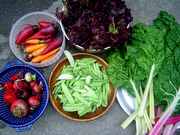

|
| Vegetable Varieties for Gardeners is a citizen science program
|
|
|
|
'Red Swan' Beans |
| |
| Sub-Category: |
Bush
Purple
|
| |
|
| Sub-Category 2: |
| | Description: |
Purple-podded bush bean. Plants bear string-free, 4- to 5-inch, dusty red-rose pods. A stabilized cross between a purple snap bean and a pinto.
|
| Days To Maturity: |
52-58
|
| Seed Sources: |
Seed Savers Exchange - updated in 2014
|
| |
| Rating Summary |
| |
Overall: (5.0 Stars)
Taste: (4.5 Stars)
Yield: (5.0 Stars)
Ease/Reliability: (4.5 Stars) |
| |
| Reviews |
| |
Login to share your Review of Red Swan.
Number of Reviews: 2
KEY: O=Overall Rating, T=Taste, Y=Yield, E=Ease
Reviewed on 07/27/2021 by
v_gardener
- An intermediate gardener
|
 Overall Overall
 Taste Taste
 Yield Yield
 Ease Ease
|
Westchester, New York, United States
Frost Free Season: 163 - 183 days
Soil Texture: Not Sure
Garden Size: Small - Less than 400 square feet (20' x 20')
Sun Exposure: 6 to 8 hours per day
|
| The red swan bean variety was new in my garden this year. Such a beautiful color, and has a great yield. Germination was no different from other varieties- about 3 days in hot summer. Flowers are a gorgeous pink, but I found that my Dragon Tongue beans which were planted at the same time, produced their first beans quicker. Great taste and turns green when cooked! |
| |
|
Reviewed on 12/27/2014 by
UpstateJohn
- An experienced gardener
|
 Overall Overall
 Taste Taste
 Yield Yield
 Ease Ease
|
Monroe, New York, United States
Frost Free Season: 143 - 163 days
Soil Texture: Loam
Garden Size: Large - More than 1,600 square feet (40' x 40')
Sun Exposure: More than 8 hours per day
|
| 2014 a trial of the Red Swan bean was added to our gardens. We used a double row layout for this trial. Germanation was fast, great blossom set, and the output was steady with a generous yield. A decent flavor fresh, steamed or boiled. We froze about 6 quart bags, and they cooked up and tasted ok, but the fresh snap is the best for this variety. |
| |
|
|
|
|
Vegetable Varieties for Gardeners is a citizen science program, © 2004-2024, All Rights Reserved
Cornell Garden Based Learning, Cornell University College of Agriculture & Life Sciences, Horticulture Section
|






 VVfG home
VVfG home
 Ease
Ease